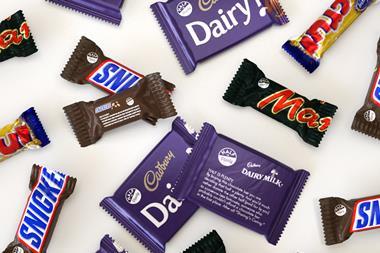Supermarkets have long had additional services tacked on to their offer to allow shoppers to pick up their dry cleaning, process their photos or get a hair cut while they shop. Recognising that there are some things they do better than others, and perms and pressing pleats are probably not two of them, grocery retailers have traditionally allowed other providers to fill the gaps and the marriage has been a happy one.
Things are changing, however. Brand hosting is now the watchword, and Sainsbury is the most enthusiastic new host on the block offering prime space to what are effectively competitor retail brands. Boots, Starbucks, the Early Learning Centre and Adams are all operating from within the main selling space in a growing number of Sainsbury stores.
But just why is it going down this route when its competitors are increasingly turned off by the idea of handing over chunks of business however specialist or non-core' to anyone else.
When a six-store trial with Boots was announced in July as well as taking over the pharmacy, Boots offers a retail range alongside the Sainsbury offer everyone applauded the Nottingham pretender's audacity in swinging such a deal. It was everything the high street stalwart needed prime out of town retail space with an established footfall and at minimal cost. And the risk to the wellbeing giant was nominal to non-existent. But analysts then and now question the long-term payback for Sainsbury.
Seven months on and Boots is happily ensconced in six key stores nationwide. In fact, it loves the concept so much it has abandoned its costly standalone international expansion strategy in favour of such tenancies. But the sceptics continue to voice doubts about the benefit the deal brings Sainsbury's shareholders. And while Boots talks about "encouraging" Christmas trading, Sainsbury refuses to comment on what it emphasises is a trial.
The sceptics' concerns are manifold. Sainsbury's strategy, under chief executive Sir Peter Davis, of focusing on the group's core food capability is well known. But if those that can, do, what is Sainsbury saying about the power of its brand; its expertise in what is, after all, a key grocery category; and its ability to milk precious floor space for the best possible returns? And then there is the potential damage to the economies of scale if chunks of turnover in this growth category the supermarkets are predicted to increase their share of the health and beauty market from 43% in 2000 to 60% in 2005, a value of about £8.4bn are tossed out with the redundant fixtures and fittings.
"It is surprising that Sainsbury doesn't consider health and beauty a core competence," says Verdict chairman Richard Hyman, echoing the concern of many analysts. "This is an admission they think Boots can do much better in this category and that the Sainsbury brand is not as strong as they would like. If health and beauty is not a key area for them, where do they draw the line?"
And it is not only in health and beauty that Sir Peter has said, "you guys have a go". Children's clothing specialist Adams, and toy experts the Early Learning Centre have a presence between them within the core selling space in 97 and 311 stores respectively, while Starbucks is happily frothing up sales in 28 prime Sainsbury outlets. Yet these are areas in which Sainsbury ought to be able to excel.
Why else take on the design services of fashion personality Jeff Banks and spend time, money and energy establishing the sub brand Jeff & Co if you do not have the confidence to take it into children's clothes? In fact, analysts point out that the category's profitability is in question and the rollout slower than expected. And why, with an extensive premium coffee range, is Sainsbury prepared to hand over category supremacy to Starbucks?
Offering customers what they want is what brand hosting is all about, says Sainsbury's head of service marketing Colin Wagstaffe. "Sainsbury wants to be first and foremost famous for food and that is why we are focusing our resources on getting the food offer right. But we do need a credible and appropriate non-food offer. We do non-food very well in certain respects, for instance our new men's toiletry range, but there are some things our customers want where we can't add value and it is not appropriate to divert resource away from developing the food offer."
And there is room yet for these partnerships to be expanded. While Wagstaffe acknowledges there may be a limit to the number of brands consumers would expect to see under one roof as well as the amount of space that should be out of the group's control he believes different solutions will be appropriate for different stores as long as there is a logical fit with a quality brand and the nature of the shopping experience.
The only tie-up he rules out is in allocating space to another food brand.
Not everyone believes the strategy is worthy of escalation. As Credit Lyonnais retail analyst Paul Smiddy notes: "This has already created more of a bazaar than a holistic shopping experience, and I personally don't enjoy that."
But as the rejuvenation programme frees up space that is not being used productively, Wagstaffe anticipates the numbers and scope of partnerships will increase. And if anyone is looking for the next category link up, Wagstaffe talks enthusiastically about the fit between the superstore offer and the motor accessory sector.
Wagstaffe is tight-lipped about how Sainsbury's concessions are doing, and to what extent they are benefiting the business, although he does suggest they are meeting customer needs and helping to attract and retain customers high-spending families have to be on any supermarkets' target list. For analysts, Sainsbury's extensive welcome to other brands is symptomatic of a store group in catch-up mode. At least it is about trying something different, they note. And while few have much to say in its favour about the Boots' trial, others are more approving of Sainsbury's pragmatic thinking.
"Sainsbury recognises that it can't be a jack of all trades and it has made a sensible decision as to whether it wants to offer leading edge or knock off," says Teather and Greenwood retail analyst David Stoddart. "However well it did its coffee offer, it could never do it as well or as efficiently as a brand such as Starbucks, so there would be lots of people saying it's not as good as Starbucks' and that's not the frame of mind in which you want your shoppers to enter the store."
It could be argued that the same now applies to convenience retailing on forecourts. As consumers get to know the concepts thanks to a more dramatic version of brand hosting offered by the likes of Sainsbury Local and Tesco Express, it will be increasingly difficult for the petrol companies to offer anything other than second best. Forecourt retailing for the multiples has not taken off to anywhere near the extent that was expected. The devil seems to be in the detail, both in agreeing terms and successfully executing a multiple convenience offer in the confines of a petrol environment. But the challenges aren't insurmountable. And as this latest development gathers pace it provides further evidence of how the traffic flow between different retail brands is not all one way.
Despite the recent interest, parking supermarket brands under other retail umbrellas is not a new phenomenon; rather the rekindling of an old flame, with supermarket offers a feature in many traditional department stores until the 1970s. However, that does not guarantee such partnerships will be an automatic success.
In January, Bhs kicked Iceland out of five of the nine stores in which it had been operating since 2000. The move followed a reassessment by BHS of "appropriate store formats". It is all a far cry from the 4,000 new jobs and 100 Iceland Bhs food halls talked about two years ago.
Neither store group each of which is under new management since the original deal was struck is keen to comment in detail. Bhs dismisses it as a "tiny bit of our business" and barely worth a mention, while Iceland says: "The move is entirely consistent with our recovery strategy to strengthen Iceland's core businesses, improve its 760-strong nationwide store portfolio and capitalise on its position as the UK's only integrated food provider."
So why did that partnership or Iceland's earlier venture with Littlewoods go wrong? The answer must lie in the fact that such partnerships can only work in one of two ways either as a margin generator or a footfall generator. And with a quality M&S convenience offer in every town and city centre, it is difficult to see how the Iceland brand could prove a great pull. High street retail space is costly and a middle of the road food offer does not pay. As Credit Lyonnais' Smiddy suggests: "My guess is that the Bhs team became much more confident about its own business and needed more footage for its clothing offer."
But that's not to say supermarket brands in non food retail environments will never work. M&S has proved that with its lunchtime tie-up with WH Smith. The beauty of the arrangement is that it was something WH Smith was doing already, albeit without any great clout, and had to continue to provide due to the nature of its stores. But WH Smith is not a food brand and had no credibility in the category. Bringing M&S into the equation enhanced the authority of the offer and has proved a major pull to passing traffic. Currently on offer in railway stations, hospitals and airports, both businesses continue to look for new locations through which M&S products could be sold.
Going forward, it's logical to assume that retail brands will continue to seek new associations and joint ventures in a number of guises, not least as retail space becomes more precious, shopping continues to delineate into various modes of consumption on-line, leisure and convenience and shoppers become more demanding in the levels of service and range of quality brands they expect.
In Guernsey, for example, the Le Riche chain recently opened its new Checkers store complete with Early Learning Centre and Adams outlets to meet demand in the Channel Islands for children's clothes retailers.
For Sainsbury, Wagstaffe is cautious not to anchor the future of non-food too firmly to individual partnerships, noting that everything about the business is constantly under review. In the meantime, the approach is paying dividends because it provides Sainsbury with ready access to other retailers' skills and learning.
"By approaching them as partnerships we can really understand the mistakes these brands have made in the past and ensure we don't make the same ones," he says.
But what happens when Sainsbury has learnt the lessons and gained the expertise it needs? As one analyst warns: "For the concessions this is not the most secure foundation for growth. If Sainsbury decides, you could be out on your ear tomorrow."
Yet Wagstaffe insists these partnerships do not come with a built-in sell by date. "This isn't about us cynically mugging these guys up a dead end alley," he says. Neither does that mean Jeff & Co will not be looking to extend into the younger market. "Sainsbury has 10 million customers with many different needs, and different brands appeal to different people. This is a fascinating and complex business with lots of possible scenarios across different stores," Wagstaffe adds.
Analysts are not convinced the Sainsbury strategy will win a lot of imitators, although many accept that retailers will continue to experiment with tie-ups albeit on an adhoc basis.
"Tesco and Asda have built up a lot of expertise in non-food and in the coming year it will be a real driver of sales. Sainsbury is going to have to run very fast down this route if it is to catch up," notes Hyman.
Ironically, some suggest it was Sainsbury's failed historical foray down the partnership route in the form of the Savacentre joint venture with Bhs that put the store group on the back foot in non food in the first place.
Handing over space is never going to be a palatable concept for many retailers. Arrangements that work will be those that are formed on a pragmatic basis, have a logic connecting the two brands and which combine the clout of both to offer the consumer more than the sum of the individual parts.
It does not look like a trend that's going to catch on, but even for those retailers who do see benefits, the partnerships are unlikely to be long-lived. n
{{COVER FEATURE }}
Close menu
- Home
- Retail & Wholesale
-
Products & Suppliers
- Back to parent navigation item
- Products & Suppliers
-
Product Categories:
- Back to parent navigation item
- Product Categories:
- Alcoholic drinks
- Bakery
- Cereals & breakfast
- Cheese
- Chicken & poultry
- Chocolate
- Confectionery
- Crisps, nuts & snacks
- Dairy
- Fish
- Fresh produce
- Frozen
- Household
- Meat
- Own Label
- Sauces & condiments
- Seasonal
- Soft drinks
- Vaping
- Vegan & plant-based
- World foods
- Suppliers
- People
- Reports & Data
-
Topics A-Z
- Back to parent navigation item
- Topics A-Z
-
Popular topics:
- Back to parent navigation item
- Popular topics:
- Cost of living crisis
- Crime
- Deposit Return Schemes
- Finance
- Government & Regulation
- Health
- Inflation
- Loyalty
- Marketing
- Mergers & Acquisitions
- New Product Development
- Sourcing
- Supply chain
- Sustainability & environment
- Technology
- Ultra Processed Foods
- Vaping
- A-Z all topics
- Content by type:
- Events
- Ask iA (beta)
- Subscribe now
Sign in to comment on this article
Not logged in before? Register for FREE guest access today.
You will be able to:
- Read more stories
- Receive daily newsletters
- Comment on stories
Advert
















No comments yet